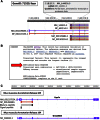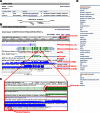Mouse genome annotation by the RefSeq project
- PMID: 26215545
- PMCID: PMC4602073
- DOI: 10.1007/s00335-015-9585-8
Mouse genome annotation by the RefSeq project
Abstract
Complete and accurate annotation of the mouse genome is critical to the advancement of research conducted on this important model organism. The National Center for Biotechnology Information (NCBI) develops and maintains many useful resources to assist the mouse research community. In particular, the reference sequence (RefSeq) database provides high-quality annotation of multiple mouse genome assemblies using a combinatorial approach that leverages computation, manual curation, and collaboration. Implementation of this conservative and rigorous approach, which focuses on representation of only full-length and non-redundant data, produces high-quality annotation products. RefSeq records explicitly link sequences to current knowledge in a timely manner, updating public records regularly and rapidly in response to nomenclature updates, addition of new relevant publications, collaborator discussion, and user feedback. Whole genome re-annotation is also conducted at least every 12-18 months, and often more frequently in response to assembly updates or availability of informative data. This article highlights key features and advantages of RefSeq genome annotation products and presents an overview of NCBI processes to generate these data. Further discussion of NCBI's resources highlights useful features and the best methods for accessing our data.
Figures




Similar articles
-
Reference sequence (RefSeq) database at NCBI: current status, taxonomic expansion, and functional annotation.Nucleic Acids Res. 2016 Jan 4;44(D1):D733-45. doi: 10.1093/nar/gkv1189. Epub 2015 Nov 8. Nucleic Acids Res. 2016. PMID: 26553804 Free PMC article.
-
Comparison of RefSeq protein-coding regions in human and vertebrate genomes.BMC Genomics. 2013 Sep 25;14:654. doi: 10.1186/1471-2164-14-654. BMC Genomics. 2013. PMID: 24063302 Free PMC article.
-
NCBI reference sequences (RefSeq): a curated non-redundant sequence database of genomes, transcripts and proteins.Nucleic Acids Res. 2007 Jan;35(Database issue):D61-5. doi: 10.1093/nar/gkl842. Epub 2006 Nov 27. Nucleic Acids Res. 2007. PMID: 17130148 Free PMC article.
-
VEGA, the genome browser with a difference.Brief Bioinform. 2005 Jun;6(2):189-93. doi: 10.1093/bib/6.2.189. Brief Bioinform. 2005. PMID: 15975227 Review.
-
NCBI genetic resources supporting immunogenetic research.Rev Immunogenet. 2000;2(4):461-7. Rev Immunogenet. 2000. PMID: 12361089 Review.
Cited by
-
Trends and Applications of Omics Technologies to Functional Characterisation of Enzymes and Protein Metabolites Produced by Fungi.J Fungi (Basel). 2021 Aug 27;7(9):700. doi: 10.3390/jof7090700. J Fungi (Basel). 2021. PMID: 34575737 Free PMC article. Review.
-
Immune responses to the real world.Lab Anim (NY). 2017 Dec 29;47(1):13-14. doi: 10.1038/laban.1384. Lab Anim (NY). 2017. PMID: 29297473 No abstract available.
-
Alga-PrAS (Algal Protein Annotation Suite): A Database of Comprehensive Annotation in Algal Proteomes.Plant Cell Physiol. 2017 Jan 1;58(1):e6. doi: 10.1093/pcp/pcw212. Plant Cell Physiol. 2017. PMID: 28069893 Free PMC article.
-
The state of play in higher eukaryote gene annotation.Nat Rev Genet. 2016 Dec;17(12):758-772. doi: 10.1038/nrg.2016.119. Epub 2016 Oct 24. Nat Rev Genet. 2016. PMID: 27773922 Free PMC article. Review.
-
Generation and analysis of a mouse multitissue genome annotation atlas.Genome Res. 2024 Nov 20;34(11):2108-2117. doi: 10.1101/gr.279217.124. Genome Res. 2024. PMID: 39443154 Free PMC article.
References
Publication types
MeSH terms
Grants and funding
LinkOut - more resources
Full Text Sources
Other Literature Sources

